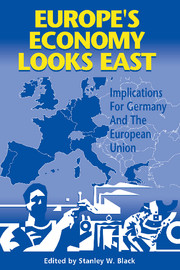Book contents
- Frontmatter
- Contents
- List of figures and tables
- Preface
- List of conference participants
- List of acronyms
- 1 Introduction
- I Trade relations
- 2 An economic assessment of the integration of Czechoslovakia, Hungary, and Poland into the European Union
- Comments
- 3 Potential trade with core and periphery: industry differences in trade patterns
- Comments
- 4 Impact on German trade of increased division of labor with Eastern Europe
- Comments
- II Investment patterns
- III Labor market issues
- IV The process of integration
- Index
Comments
Published online by Cambridge University Press: 03 February 2010
- Frontmatter
- Contents
- List of figures and tables
- Preface
- List of conference participants
- List of acronyms
- 1 Introduction
- I Trade relations
- 2 An economic assessment of the integration of Czechoslovakia, Hungary, and Poland into the European Union
- Comments
- 3 Potential trade with core and periphery: industry differences in trade patterns
- Comments
- 4 Impact on German trade of increased division of labor with Eastern Europe
- Comments
- II Investment patterns
- III Labor market issues
- IV The process of integration
- Index
Summary
This paper addresses topics of considerable concern to both policymakers and researchers. For example, how will trade flows from transitioning economies in Eastern Europe affect economies in the West? How important are restrictions on trade in “sensitive” sectors? The paper also presents a variety of interesting facts and figures about recent trade developments.
I see two main conclusions of the paper. First, it documents that there has been a significant increase in trade between the CEEC-6 and its Western European trading partners, especially Germany. Second, the rise in Western European imports of “sensitive” goods has been quite a bit smaller than the overall rise in imports and the paper suggests that this is largely attributable to trade restrictions. The paper's two main findings are broadly sensible. However, I have some questions about aspects of the paper. I would also like to offer some alternative interpretations of some of the authors' findings. In my comments, I will follow the general outline in the paper.
The first section of the paper provides a useful and informative overview of recent developments in trade flows between the CEEC-6 and five Western European countries. In particular, it documents that trade with the CEEC-6 has increased as a share of the West's total trade, and that Germany, France, Italy, and the UK (but not Portugal) have seen an improvement in their trade balances vis-á-vis the CEEC-6.
- Type
- Chapter
- Information
- Europe's Economy Looks EastImplications for Germany and the European Union, pp. 97 - 99Publisher: Cambridge University PressPrint publication year: 1997

